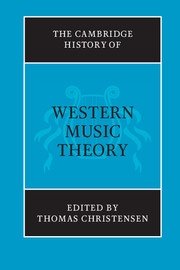Book contents
- Frontmatter
- Introduction
- PART I DISCIPLINING MUSIC THEORY
- PART II SPECULATIVE TRADITIONS
- 4 Greek music theory
- 5 The transmission of ancient music theory into the Middle Ages
- 6 Medieval canonics
- 7 Tuning and temperament
- 8 The role of harmonics in the scientific revolution
- 9 From acoustics to Tonpsychologie
- 10 Music theory and mathematics
- PART III REGULATIVE TRADITIONS
- PART IV DESCRIPTIVE TRADITIONS
- Index of authors
- Index of subjects
- References
9 - From acoustics to Tonpsychologie
from PART II - SPECULATIVE TRADITIONS
Published online by Cambridge University Press: 28 March 2008
- Frontmatter
- Introduction
- PART I DISCIPLINING MUSIC THEORY
- PART II SPECULATIVE TRADITIONS
- 4 Greek music theory
- 5 The transmission of ancient music theory into the Middle Ages
- 6 Medieval canonics
- 7 Tuning and temperament
- 8 The role of harmonics in the scientific revolution
- 9 From acoustics to Tonpsychologie
- 10 Music theory and mathematics
- PART III REGULATIVE TRADITIONS
- PART IV DESCRIPTIVE TRADITIONS
- Index of authors
- Index of subjects
- References
Summary
The rise of Tonpsychologie as a scientific discipline in the nineteenth century was a key moment in the history of music theory. It revived topics hitherto situated in the venerable, although largely enfeebled, study of speculative harmonics, and at the same time prefigured future directions for research in music perception. In the final third of the century, this research field underwent two major epistemological shifts that revolved around the German polymaths Hermann von Helmholtz (1821–94) and Carl Stumpf (1848–1936). Both of these scientists were accomplished amateur musicians; both were avidly interested in music theory. Using experimental methods to study pitch organization and the physiology of hearing, they tried to answer age-old ontological questions of musica theorica: what are the origins and nature of musical sound, consonance, harmony, and scales? In so doing, they offered fresh perspectives that can be appreciated only by distinguishing their individual viewpoints and by reviewing the long prehistory of their work.
The scientific revolution of the seventeenth century gave birth to the experimental/empirical methods of natural science and stirred interest in the physical basis of pitch organization. Physical acoustics fascinated investigators from Mersenne to Helmholtz and largely replaced the dominating mode of speculative, numerical inquiry. Questions about harmony and about consonance and dissonance were now evaluated acoustically rather than by reference to canonics. By the middle of the nineteenth century it became apparent that experimental methods could be applied not only to the physics of music but also to the physiology of hearing and the psychology of perception.
- Type
- Chapter
- Information
- The Cambridge History of Western Music Theory , pp. 246 - 271Publisher: Cambridge University PressPrint publication year: 2002
References
- 15
- Cited by



